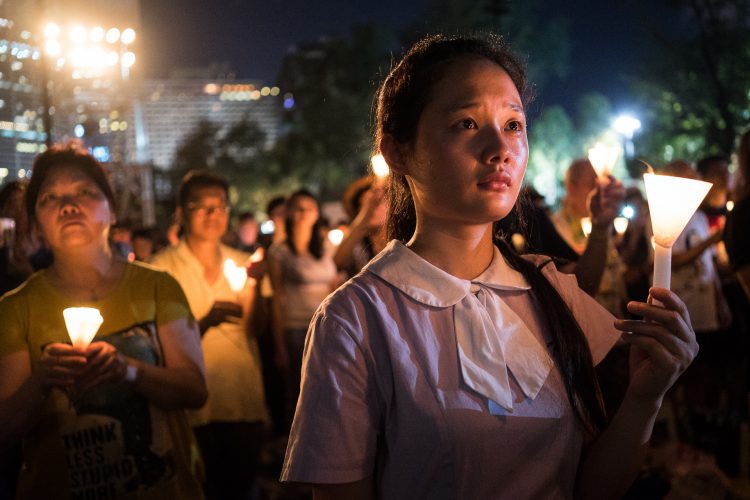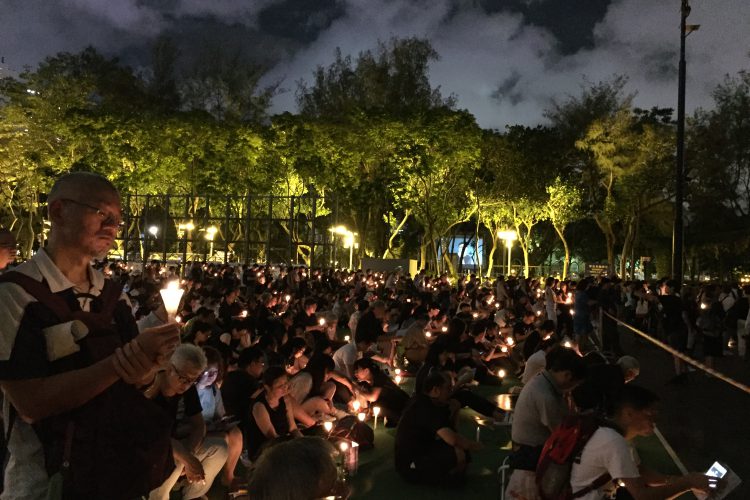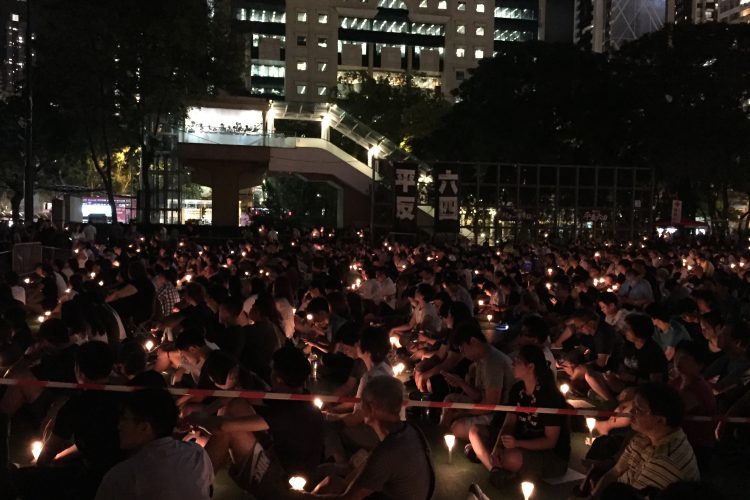Interview with Luke Ching
18 July 2018
Hong Kong
You always use conceptual art as ways of intervening the society or responding to politics. Why do you choose this as a way of expression?
Recently, the way of creating that I care about is finding the role of artists in a civil society. Instead of considering my works as separate entities, I think about what that role is. It’s because I think within the structure of the society, our imagination is compact, meaning that borders between categories are well-defined. For instance, when we look at opposing political ideologies, the borders are actually very close to one another. For me, an artist’s role in citizen-facing, public discussions is to loosen or connect these borders. I always say an artist has two roles. One is to be an indicator, like a chemical reagent, to look at what is hidden in the world or city—something that exists but is hidden and everybody doesn’t realise [its presence]; our role [as artists] is to make them visible. The second role is to connect things that are seemingly unrelated. I call this a catalyst.
Many of your works deal with changes happening in the city. Why is the city an important theme to you?
Since the 2000s, most of those who discussed my works [has said that I] play the role of a flâneur, in Walter Benjamin’s terms. The flâneur refers to an observer in the city—someone who maintains a distance while observing. But after being [the flâneur] for a few years, you feel like there’s still a sense of alienation, and it doesn’t feel alright. Since then, this sense of distance has started to narrow down for me. I need to enter [the society] to witness the changes, or participate in social movements.
Among all the social issues, I focus particularly on those related to labour. It’s because as I mentioned before, I want to find the imagination within this identity. What are the possibilities of labour movements? The borders are actually strange. The trend in Hong Kong’s discussion of politics is predominantly focused on its constitutional development and establishment. Currently, it’s very narrow, meaning that there is very little room for us to push forward developments. In response to this imagination, I think about what “everyday democratisation” means. One of the roles of everyday democratisation is based on the fact that people need to go to work everyday, and no matter how democratic a nation is, the work place is inherently autocratic. For instance, if you work for 12 hours, or 10 hours, you’re inside an autocratic country for those hours. This life is not democratic. Rethinking how labour movement is about everyday democratisation, and narrowing the distance between everyone for equal rights, is what I’ve been most interested in recently. After the Umbrella Movement, whether you’re pro-establishment or the opposition, there’re a lot of borders defining different political stances. These borders are basically non-negotiable. Everyone knows their positions and has a sense of distance. What we urgently need at this moment in time is to rethink how to dissolve these borders, and to generate a new “us”. That’s why in the past two years, we’ve been creating a new identity called “wage earners”.
I remember the first project idea I proposed to Dr. Yeewan Koon was about organising labour movements in Gwangju. Actually in Korea, it’s relatively difficult for foreign companies to enter the domestic market. But Watsons is incredible. At the time, it is the only retail brand, one of the chain stores in Gwangju. In my early years, I had run campaigns to demand chairs for [workers who need to stand at their posts], and one of those which changed their policies was Watsons. I thought about whether it’s possible to export these campaigns to Korea, and changed how Watsons staff is being treated in the entier Korea, starting from chairs. It’s quite an ambition initially. Everyone wasn’t sure about it. But I don’t know if it’s a good thing or not, four months after I visited [Gwangju], Watsons was acquired by a Korean company. There is no longer [an element of] a Hong Kong-based retail company in this idea.
How do the works you are showing at Gwangju Biennale 2018 respond to the different borders you just mentioned?
I thought about what a biennale is—what its nature is. To a certain extent, it is a form of cultural exchange, and a process involving tourism, because for example, I need to visit there for around four times back and forth, or other artists also travelled from their own countries. Every time [we] pass through a major border, like the airport or one’s own national border. Those are obvious and representational borders. This makes me start thinking from the tourism aspects [of the biennale]. What is the purpose of travelling? What can be the imagination in it? It connects back to my previous project called “crime committing in contexts”. In fact, this has a really simple logic. The logic is, for the recent few years, we always talk about how rule of law should be emphasized in Hong Kong—that law is important—and we should abide by the laws. But in shifting contexts, for instance, if something is illegal in Hong Kong, it might actually be legal in Korea. It [law] is relative. It may seem whimsical and absurd—to travel there by airplane and perform a trivial action—like eating in the subway. But the videos, based on such simple logic, extend local stories from Hong Kong as well. In Korea, you cannot fly drones at night. In the context of Hong Kong, it’s still allowed; it’s prohibited in regulations, but it doesn’t say so in the law. You start to think about at what times drones are visible at night in Hong Kong, and why you need to use drones to view Hong Kong from a bird’s eye view. In our daily lives, it may be for the annual June 4th candlelit vigil. If you’ve attended the vigil before, there’re always many drones in the sky, trying to capture scenes of the candle lights, to see it from an aerial perspective.
루크 칭과의 인터뷰
2018년 7월 18일
홍콩
작가님은 개념 미술을 정치 상황에 응답하거나 사회 문제에 개입하기 위한 수단으로 사용해 오셨습니다. 이러한 방식으로 표현하게 된 이유는 무엇인가요?
최근에 관심을 가지게 된 창작 방법은 시민 사회에서 예술가들의 역할을 찾는 것입니다. 제 작품들이 완전한 독립체라고 생각하지 않고 그것이 가질 수 있는 역할에 대하여 고민합니다. 우리의 상상력은 사회 구조 내에서 편협해지고, 이는 카테고리들 사이의 경계가 뚜렷해짐을 의미하기 때문입니다. 예를 들자면, 서로 대립되는 정치적 이데올로기를 생각하면 그 사이의 경계들은 사실상 매우 밀접해 있습니다. 저에게 있어서, 예술가가 시민들을 만나고 대중들과 의논하는 것은 이러한 경계들을 느슨하게 하거나, 혹은 연결시켜 주는 일입니다. 예술가에게는 두 가지의 역할이 있습니다. 첫 번째는 화학 시약처럼 무언가를 나타내는 일인데, 예술가들은 세계나 도시 안에서 숨겨진 것들을 찾아 분명히 존재하지만 가려진 아무도 모르는 그것들을 모두가 볼 수 있게 만들어야 합니다. 두 번째는 언뜻 보기에 관련 없는 일들을 연결시키는 일입니다. 저는 이걸 촉매라고 부르죠.
작품들 중 대다수는 도시 내에서 일어나고 있는 변화를 다루고 있습니다. 왜 도시라는 테마가 중요한가요?
2000년대부터, 많은 사람들이 제 작품을 놓고 월터 벤자민이 말하는 “플라뇌르 (flaneur)” 같다고 했습니다. 플라뇌르는 도시의 관찰자라는 뜻인데, 관찰하면서도 일정 거리를 유지합니다. 그러나 몇 년 정도 그 짓을 하다 보면 계속해서 소외되는 느낌이 들고, 기분이 썩 좋지는 않아요. 그 이후로 저는 도시와의 간격을 좁히기 시작했습니다. 사회에 들어서야만 변화를 목격하거나 사회적 운동에 참여할 수 있으니까요.
사회적 이슈들 중에서도 저는 특히 노동에 관련된 일들에 주목합니다. 이전에도 언급했지만, 노동자라는 아이덴티티 안에서의 상상력을 찾아내고 싶기 때문입니다. 노동 운동은 어떠한 가능성들을 가지고 있는가? 경계들이란 사실 이상합니다. 홍콩 정치 담화의 트렌드는 대부분이 헌법적 개발과 확립에 초점이 맞춰져 있습니다. 요즘 초점이 더욱 좁아져서는 발전을 위해 앞으로 밀고 나갈 공간이 거의 없습니다. 이러한 상상력에 응답하기 위해 “일상적 민주화”가 무엇인지 생각해보곤 합니다. 일상적 민주화의 역할 중 하나는 사람들은 매일 출근해야 한다는 사실에 기반합니다. 그 국가가 얼마나 민주적이든 간에, 일터는 본질적으로 독재 영역입니다. 예를 들어, 12시간이든 10시간이든 일하는 동안에는 한 독재 국가 안에 있는 것과 다름이 없죠. 이러한 삶은 민주적이지 않습니다. 제 최근 관심사는 노동 운동이 어떻게 일상적 민주화와 연결되는지 탐구하고 동등한 권리를 위하여 모든 이들 사이의 거리를 좁히는 것입니다. 우산혁명 이후로 당신이 헌법 확립 지지자이든 아니든 간에, 수없이 많은 경계들이 서로 다른 정치적 견해를 규정하게 되었습니다. 이러한 경계들은 기본적으로 타협될 수 없습니다. 누구나 각자의 위치 사이사이 특정 거리가 있다는 걸 압니다. 이 순간에서 우리에게 급히 필요한 것은 새로운 “우리”를 만들기 위해 이 경계들을 어떻게 녹일 수 있는가, 입니다. 이게 우리가 지난 2년 동안 “임금 노동자”라는 새로운 아이덴티티를 창조해 온 이유입니다.
내가 기억하기로 이완 쿤 박사님에게 제일 처음 제안한 프로젝트 아이디어는 광주의 노동 운동 기획과 관련되어 있었습니다. 사실상 한국에서는 외국 기업이 국내 시장을 뚫기가 상대적으로 힘듭니다. 그래도 왓슨스는 정말, 엄청날 정도였죠. 원래 광주에 체인 점포들을 둔 그저 그런 소매 브랜드 중 하나일 뿐이었습니다. 활동 초기에 서비스직 노동자를 위한 의자 놓기 캠페인을 진행했는데, 규정을 바꿔준 회사 중 하나가 왓슨스였습니다. 한국에 이런 캠페인을 가져갈 수는 있나, 하고 생각했는데 의자로부터 시작해 전국 왓슨스 직원들의 업무 환경을 바꾸어 놓았습니다. 처음부터 패기가 넘쳤었네요. 모두가 이게 과연 될까? 하고 생각했으니까요. 이게 좋은 일인지 나쁜 일인지는 모르겠지만 네 달 후에 광주에 와 보니 왓슨스가 한국 회사에게 매각되어 있었습니다. (랄라블라 Lalavla) 이제 더 이상 이 아이디어와 관련된 홍콩 소매 회사는 없습니다.
작가님의 2018 광주 비엔날레 전시작은 방금 언급했던 “서로 다른 경계들”에 대해 어떻게 대응하나요?
비엔날레가 무엇이고 그 본질이 무엇인지에 대해 생각해 보았습니다. 비엔날레란 특정 범위 안에서 문화 교환의 한 형태이자 관광과도 관련되어 있는데, 왜냐면 예를 들자면 예를 들자면, 저도 전시 장소를 4번 정도 왔다 갔다 해야 하고 다른 작가님들도 본국에서 왔기 때문입니다. 그 때마다 매번 공항, 국경 같은 주요 경계들을 넘어야 합니다. 공항이나 국경은 명백하고 구상적인 경계입니다. 이는 비엔날레의 관광적 측면을 생각하게 만듭니다. 여행의 목적이란 무엇인가? 여행에는 어떠한 상상력이 있는가? 이러한 질문들은 이전 프로젝트 “맥락 안에서 범죄 저지르기” 와 연결됩니다. 사실 논리적으로 매우 간단해요. 논리를 설명하자면, 최근 몇 년 동안 늘 어떻게 법이 중요하며 모두 법의 울타리 안에서 살아가도록 홍콩 법규를 강조할 수 있는지에 대해 이야기했습니다. 하지만 유동적 맥락에서는 다른데, 예를 들자면, 홍콩에서 불법인 일들이 한국에서는 합법일 수가 있습니다. 법이란 상대적입니다. 광주에 비행기를 타고 가서 지하철에서 음식 먹기처럼 사소한 행위예술을 하는 게 엉뚱하고 터무니없을지도 모르겠습니다. 하지만 그런 간단한 논리에 기반한 영상들은 홍콩 현지에서의 이야기를 연장시킬 수 있습니다. 한국에서는 밤에 드론을 날릴 수 없습니다. 홍콩의 맥락에서는 날릴 수가 있습니다. 규정에는 금지되어 있지만, 법에는 아무것도 명시되어 있지 않습니다. 이제 홍콩에서 어떤 밤 시간대에 드론을 볼 수 있는지 생각해 보면 드론이 필요한 이유는 홍콩을 한 눈에 보기 위해서죠. 일상 생활을 되짚어 보면 6월 4일 촛불 시위를 위한 것일지도 모릅니다. 시위에 참여해 본 분들은 알 테죠. 항상 하늘에 드론들을 띄워 항공 시각에서 촛불로 이루어진 풍경을 촬영하는 모습을 말입니다.







